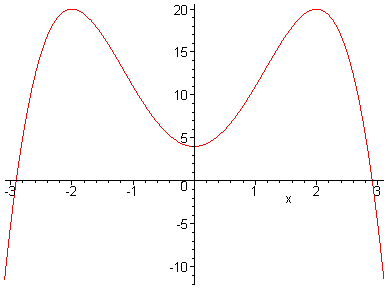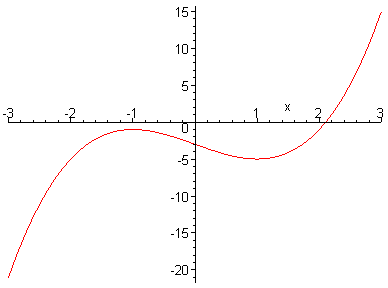|
|
Math 122 - Calculus for Biology II |
|
|---|---|---|
|
|
San Diego State University -- This page last updated 14-Oct-01 |
|
Newton's Method - Examples
|
|
Math 122 - Calculus for Biology II |
|
|---|---|---|
|
|
San Diego State University -- This page last updated 14-Oct-01 |
|
1. Consider the function
f(x) = 4 + 8x2 - x4.
a. Find the derivative of f(x) and the second derivative, f ''(x).
b. Find the y-intercept. Determine any maxima or minima and all points of inflection for f(x). Give both the x and y values.
c. Sketch the graph of f(x). Is this function odd or even or neither?
d. One of the x-intercepts is near x = 3. Use Newton's Method starting with x0 = 3 and performing two iterations to get a good approximation to this x-intercept.
a. The derivative can be found by the usual method,
b. At the y-intercept, x=0, so f(0) = 4 .
At the maxima and minima,
f '(x) = 0 = 16x - 4x3 = 4x(4 - x2) = 4x(2 - x) (2 +x)
The maxima and minima are therefore at x = 0, +2 .
f(2) = 4 + 8(2)2 - (2)4 = 4 + 32 -16 = 20
so the maxima are at (2,20) and (-2,20) and the minimum is at (0,4)
Points of inflection can be found where
f''(x) = 0= 16 -12x2 = 4(4-3 x2),
so ![]() and in this case,
f(x) = 4 + 8(4/3) - (4/3)2 = 116/9.
and in this case,
f(x) = 4 + 8(4/3) - (4/3)2 = 116/9.
c.

This is an even function, because it is a mirror image across the y-axis.
d. We begin at point x0 = 3, and then we can find
f(3) = 4 + 8(3)2 - (3)4 = -5
We also find
f '(x) = 16(3) - 4(3)3 = -60
The first Newton iterate is therefore
x1 = 3 -(-5)/(-60) = 3 - 1/12 = 35/12 = 2.917
Using this value of x, we find f(x1) and f '(x1)
f(35/12) = 4 + 8(35/12)2 - (35/12)4 = -.3125
and
f '(35/12) = 16(35/12) - 4(35/12)3 = -52.58
The second iterate is therefore
x2 = 35/12 -(-.3125)/(-52.58) = 2.9107
To check our solution, if we substitute a = x2 into this equation, f(a) = 4 + 8a - a2
then we can use the
quadratic
equation to find ![]() so
a = 4
+
4.472
so
a = 4
+
4.472
The solutions for x as the square root of a are therefore +2.9107.
Consider the function
f(x) = x3 - 3x - 3.
a. Find all extrema and points of inflection, giving both the x and y values.
b. Is this function odd, even or neither? Sketch a graph of this function.
c. Use Newton's Method to approximate the value of the x-intercept. Start with x0 = 2 and perform two iterations.
a. The derivative can be found by the usual method, in order to find the extrema
At the maxima and minima, f '(x) = 0 = 3(x2 - 1) = 3(x+1)(x-1)
The maxima and minima are therefore at x = +1.
f(1) = (1)3 - 3(1) - 3 = -5, and f(-1) = (-1)3 - 3(-1) - 3 = -1,
so the maximum is at (-1,-1) and the minimum is at (1, -5)
Points of inflection can be found where f''(x) = 6x2= 0, so x =0 and f(0) = -3.
b. This function is neither even nor odd.

c. We begin at point x0 = 2, and then we can find
f(2) = (2)3 - 3(2) - 3 = -1
We also find
f '(2) = 3(2)2-3 = 9
The first Newton iterate is therefore
x1 = 2 -(-1)/(9) = 2 + 1/9 = 19/9 = 2.111
Now we find
f(19/9.) = (19/9)3 - 3(19/9) - 3 = .07545
We also find
f '(19/9) = 3(19/9)2-3 = 10.3704
The second Newton iterate is therefore
x2 = 2.111 - (.07545/ 10.3704) = 2.1038
3. Let
f(x) = 4 ln(x) - x.
a. Differentiate f and find any critical points. Determine the domain of f and sketch the graph.
b. Use Newton's Method to approximate the value of the x-intercept. Start with x0 = 1 and perform two iterations to give the approximation of one zero. Then let x0 = 8 and find x1 to approximate the other zero.
a. The derivative of f is
f '(x) = 4/x - 1.
The only critical point is when
4/x - 1 = 0,
so x = 4. It follows that there is a maximum at (4, 4 ln(4) - 4) = (4, 1.5452). The domain is x > 0.
b. The Newton's formula is given by

It follows that when x0 = 1,

The actual intercept is x = 1.4296.
The other intercept is found by starting at x0 = 8. The first Newton iterate is

The actual intercept is x = 8.6132.